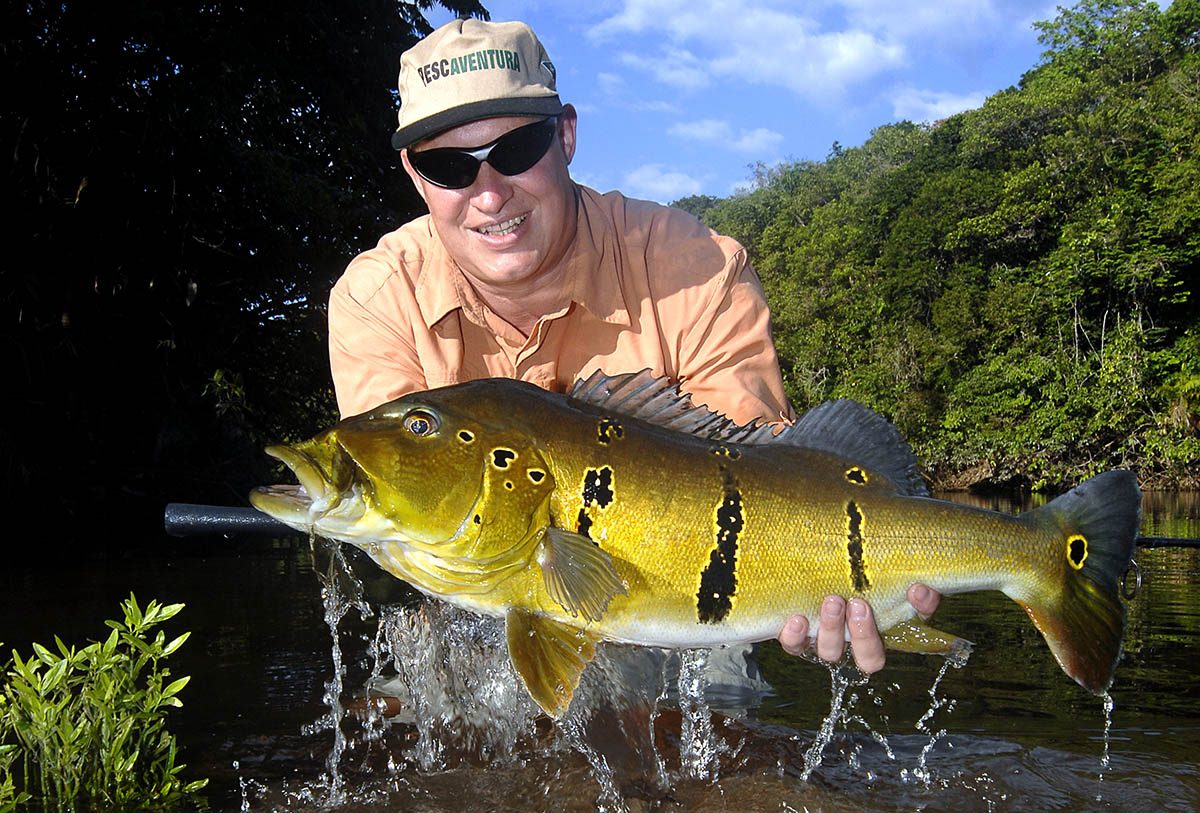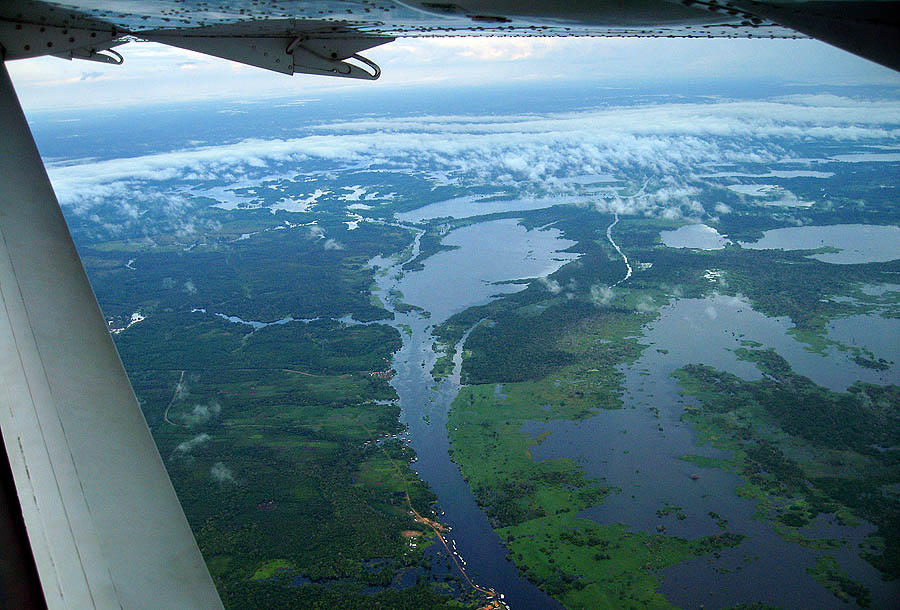 (2008-2016) At long last, I find myself in the Amazon – it has been a lifelong dream, and now it has come true. I have a big smile on my face, as Rubinho handles my camera, to photograph me holding a big, exotic looking catfish. I am standing in clear, warm water, yellow butterflies around me, monkeys howling in the trees above – the weather is phenomenal, blue skies and lovely hot. Does it get any better than this?
(2008-2016) At long last, I find myself in the Amazon – it has been a lifelong dream, and now it has come true. I have a big smile on my face, as Rubinho handles my camera, to photograph me holding a big, exotic looking catfish. I am standing in clear, warm water, yellow butterflies around me, monkeys howling in the trees above – the weather is phenomenal, blue skies and lovely hot. Does it get any better than this?
It is only my second day in the jungle, and what I have experienced and caught is already enough to call it a brilliant trip. I still have 6 more days in the jungle, plus a couple of days at Macambira, targeting the world's largest freshwater fish, the arapaima.
The River Sea
The Amazon is the largest river in the world by volume – it has a greater water flow than the 10 second biggest rives put together, and it contains as much as one fifth of the entire world's river flow. It is the second longest river; only slightly shorter than the Nile in northern Africa. The Amazon has over 1.000 tributaries, where 17 of these are more than 1.000 km long. It is a reasonable description, that it is called "The River Sea".
54% of the Amazon basin lies in Brazil, besides Peru and several other countries in the northern part of South America. Here you also find the world's greatest rainforest, covering 8.235.400 square km.
At Manaus, the rivers Negro and Solimões meet – this is an interesting sight, as you can see the distinct colour differences of these two enormous rivers, where they meet. It takes about 30 km for the two rivers to completely merge.
Copenhagen to the Jungle
It took me 1½ days to get to Manaus from Copenhagen, via Frankfurt and São Paolo; but as I sat in the small taxi plane over the vast green and blue Amazon landscape, all fatigue had morphed into excitement – ah, new adventures…
 We flew to Nova Olinda, a small and typical village in the Amazon region. However, Nova Olinda is an important connection point for traffic between the other small villages in the area, Manaus and the jungle. Here we boarded one of the special riverboats, you see everywhere in the Amazon. Our riverboat had two decks, one for the crew and cooks, and one for the costumers and the fishing operators.
We flew to Nova Olinda, a small and typical village in the Amazon region. However, Nova Olinda is an important connection point for traffic between the other small villages in the area, Manaus and the jungle. Here we boarded one of the special riverboats, you see everywhere in the Amazon. Our riverboat had two decks, one for the crew and cooks, and one for the costumers and the fishing operators.
It took the boat about 20 hours to get to the river, where we were going to fish,, and we spent the time preparing fishing tackle, getting to know the each other, eating, and getting a good night sleep the in hammocks.
Jungle Camp
They drove the riverboat as far up the small river as they deemed safe, and here we loaded equipment into a wooden boat with a "longtail" motor. I witnessed an incredible level of logistics; they brought no less than 1½ tons of ice, food, drinks, baggage, and equipment to the jungle camp in the wooden boat. The fishermen dispersed in their speedboats throughout the area for the first day of fishing.
Pescaventura had already constructed a camp in the jungle, about 3 hours boat ride upstream from the riverboat. The jungle camp was another brilliant wonder of logistics: a camp of eight 3-man tents under a structure of branches covered with big blue plastic tarpaulins, a kitchen fully equipped with freezer and fridge, giant dining table, two shower cabins and two toilets, a diesel generator to run the lights and the kitchen, the water pumps for the showers and wash basins, plus our electronic gadgets which needed recharging. They had even made steps at the boat landing and placed torches for the evening time, which was not only practical but also very atmospheric.
Jungle fishing
We had days where we targeted specific fish species, but normally we started the day hunting Tucunaré/peacock bass in the quiet backwaters, where there is little or no current. The most fun way to fish for peacock bass was with sub-surface Rapala or jerkbait. To see these mammoth multicolour, large-mouthed cichlids attack your surface bait is virtually heart stopping – followed by the terrifying battle, trying not to lose the fish in the roots and branches of the flooded rainforest.
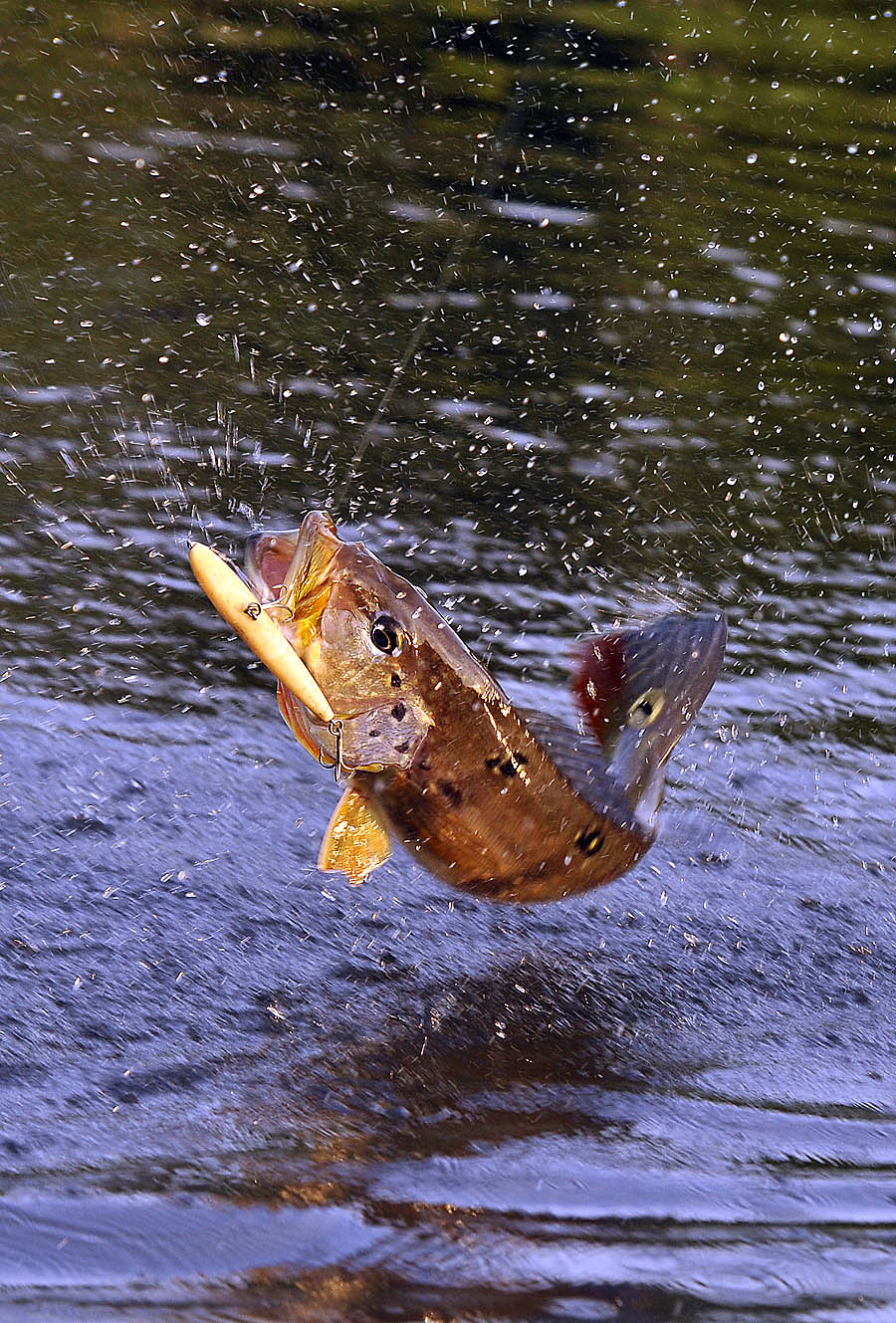 We also caught quite a few peacock bass on fly, which is no doubt the most effective method for them. You can catch many, and the average size is noticeably smaller, but we still managed to catch them to 13 lbs this way. To try and isolate the biggest fish, we used slow trolled live baits, and I must say it worked like a charm; in a morning we had 7 peacocks to 13 lbs on various live aquarium fish. Spoons and jigs also worked very well.
We also caught quite a few peacock bass on fly, which is no doubt the most effective method for them. You can catch many, and the average size is noticeably smaller, but we still managed to catch them to 13 lbs this way. To try and isolate the biggest fish, we used slow trolled live baits, and I must say it worked like a charm; in a morning we had 7 peacocks to 13 lbs on various live aquarium fish. Spoons and jigs also worked very well.
During our week in the jungle the team (7 costumers and 3 guides, who fished) caught over 150 peacock bass, with the biggest at 17½ lbs. Everybody caught peacock bass over 9 lbs, and we had as many as 43 over 7 lbs.
Later in the morning we moved further upstream to some small waterfalls, where the popular Matrinchaõ/common brycon (Brycon melanopterus) hang out. The brycon looks like a chub with small piranha teeth and beautiful colours. The brycon is popular for several reasons; it is a very ambitious predator, attacking baits which are way too big for its mouth, it tastes wonderful, but is mainly because of its fighting capabilities and its wild aerobatics. Often, you find quite a few fish in the same pool. We caught them to 7 lbs on spoons and Rapalas, but they can reach weights in excess of 9 lbs.
Below these waterfalls, where the water is deeper, you find the exotic looking shovelnose catfish - in this area it is the reticulated shovelnose (Pseudoplatystoma reticulatum), locally called Capararí. These catfish are not particularly hard to catch on natural bait, such as pieces of brycon or piranha, but they are excellent fighters. These greedy predators tend to stay together in large groups of about twenty individuals, where food is jumped on quickly because of the competition. If you put your mind to it, you can theoretically catch as many as you like. Most of the shovelnose we caught weighed between 10 and 25 lbs, and the local record is around 45 lbs.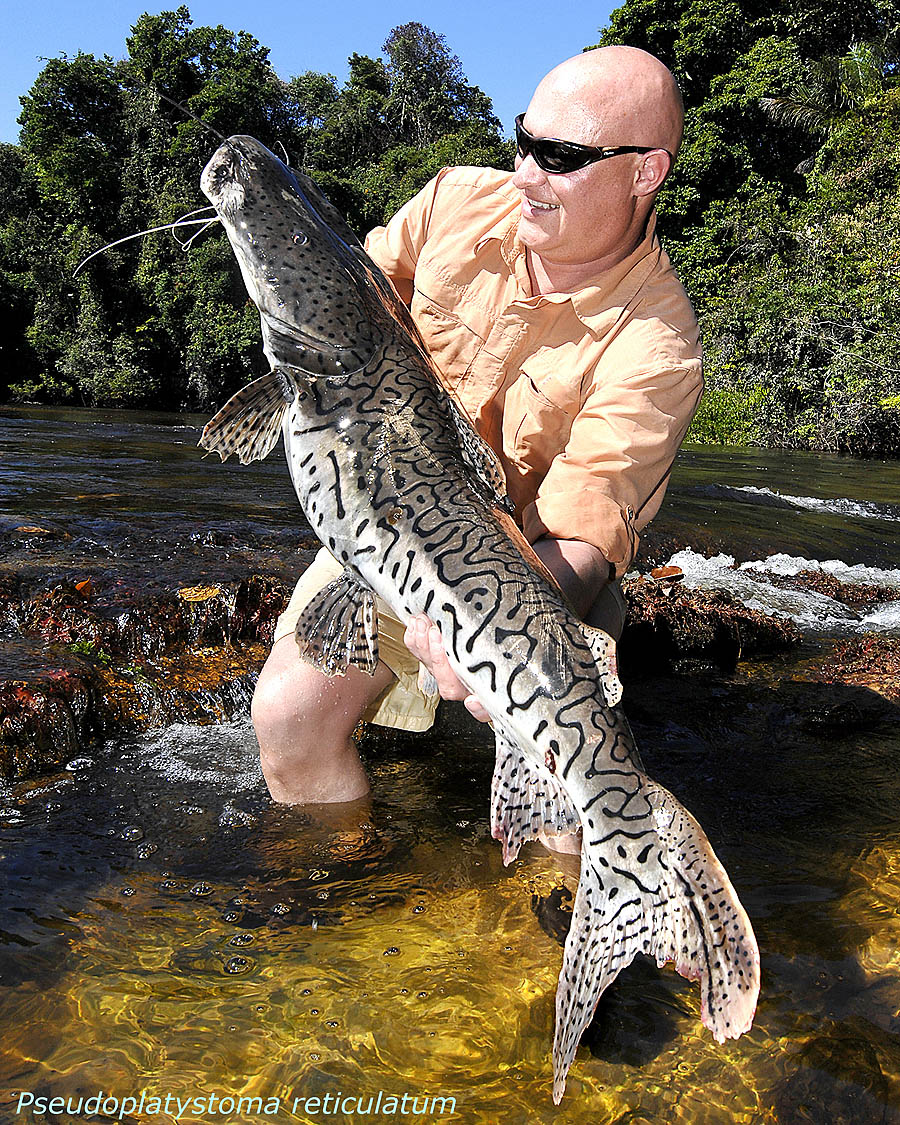
Then we get to lunchtime – and what a feast they made of it. All boats are equipped with cooking gear, hammocks, drinks on ice, a lump of meat, and some vegetables and fruit. The boat guides made a small clearing in the rainforest, started frying the fish we kept for eating, made a small dining table from sticks, and hung up the hammocks.
Before eating, I usually enjoyed a cold beer with my butt in the water, along with my newfound friend, Luiz. As it was, the menu consisted of fried piranha and shovelnose, some tender fried beef, tomatoes and cucumber, and fried bananas. Sometimes we even excelled in making sashimi from peacock bass, all with soy sauce, wasabi and lime – yummie !
After lunch it was the common thing to relax a little in the hammocks, but I always ran around photographing all sorts of stuff instead.
 Leaving the primitive lunch camp, we fished for peacock bass along the way to areas, where the river was wide and deep and the water was slow flowing. Here our intended target fish was the beautiful Pirarára, South American redtail catfish (Phractocephalus hemioliopterus). These parts of the river are also areas much preferred by piranhas, which creates some unusual problems, fishing wise. It didn't come as a huge surprise that when we used fish meat for bait, we also caught piranhas – it was ok insofar as we got more bait for the catfish, but damn they were irritating when the initial excitement of catching a piranha had abated. The worst thing that could happen was, if you hooked a big catfish and the bait slid up the line above the steel wire leader – then the fight didn't last very much longer as masses of piranhas quickly chopped through both bait and line, however powerful the main line was.
Leaving the primitive lunch camp, we fished for peacock bass along the way to areas, where the river was wide and deep and the water was slow flowing. Here our intended target fish was the beautiful Pirarára, South American redtail catfish (Phractocephalus hemioliopterus). These parts of the river are also areas much preferred by piranhas, which creates some unusual problems, fishing wise. It didn't come as a huge surprise that when we used fish meat for bait, we also caught piranhas – it was ok insofar as we got more bait for the catfish, but damn they were irritating when the initial excitement of catching a piranha had abated. The worst thing that could happen was, if you hooked a big catfish and the bait slid up the line above the steel wire leader – then the fight didn't last very much longer as masses of piranhas quickly chopped through both bait and line, however powerful the main line was.
This redtail catfish is a great fighter, heavy and with real attitude. Fish of just 15 lbs really make you work for your money, and then they growl at you, when they are near the boat. We caught them to between 30 and 100 lbs, and the IGFA all-tackle world record is 113½ lbs.
Unknown territory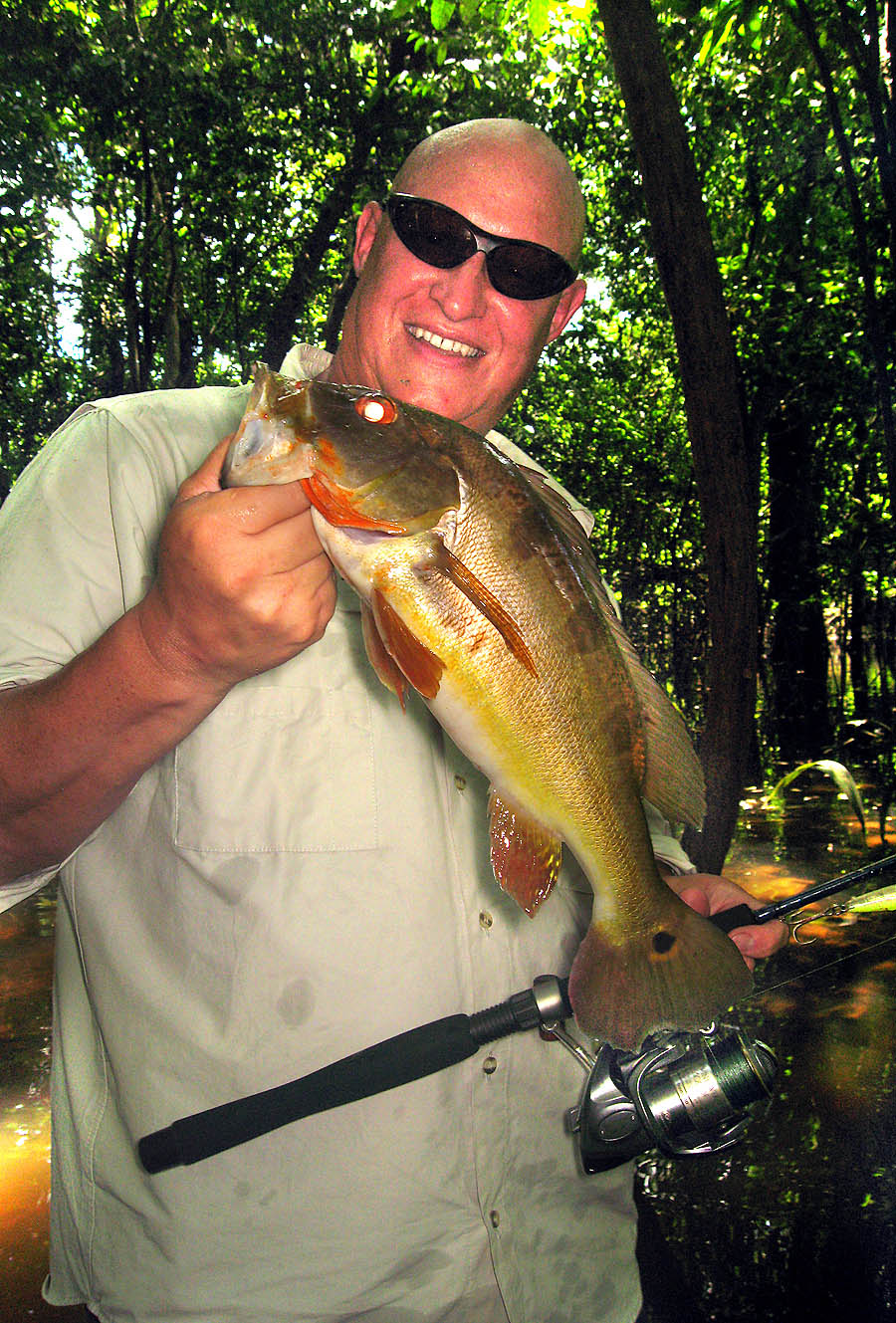
Rubinho had a plan to explore up the river, further than either he or the boat guides had ever gone before, and needless to say I was more than ready to join. It meant staying in a so-called sub-camp at night, without the sumptuous conveniences of the base camp, but in my opinion much more adventurous. Also we had to drag the boat through bigger waterfalls than we had tried before, and the boat guide brought a shotgun, for which I never really got an answer…
The new stretch of river, however, looked much the same as we had already seen, but the fishing was, if at all possible, even more prolific. We went a couple of hours upstream, and then let the boat drift back down, fishing our way back. We fished casting right to the banks, and caught many different species of characins and cichlids: peacock bass in all sizes, lots of big and wild brycon, pike characin (also called freshwater barracuda, for good reasons), several species of pike cichlid, and various species I haven't even got identified yet.
The evening fishing out from our sub-camp brought a completely unexpected fish species – to me at least. We fished for redtail catfish, as usual, and I had some good bites on the small half piranha I used for bait, but I failed to hook the fish on several strikes. In the end I gave the fish much longer time to munch the bait, and the finally I struck something solid. Well, as solid as a big eel can get, and at that a 6 foot, 15 lbs electric eel.
 I was both overjoyed and quite a bit worried – how on earth was I going to get a good trophy photograph without getting electrocuted in the process? Not a problem you deal with every day, is it? Well, I managed it by holding the wire with a glove and stretching my arm as much as I possibly could.
I was both overjoyed and quite a bit worried – how on earth was I going to get a good trophy photograph without getting electrocuted in the process? Not a problem you deal with every day, is it? Well, I managed it by holding the wire with a glove and stretching my arm as much as I possibly could.
At night we also had close encounters with some of the other inhabitants of the river – creatures I didn't even know lived there. Besides the lively and ever present pink river dolphins, we had big disk tetras jump into the boat, frightened by the powerful flashlight. Also, we could see the red reflections of the caiman's eyes everywhere, and to top it up a huge manatee frightened the living daylights out of me as it blasted its way through shallow water only a couple of feet away.
Fazenda Macambira
After a week in the jungle, we were supposed to end the trip with a night at a luxury hotel in Manaus before flying back home, but Rubinho and Mauro suggested I could stay the night at Macambira instead, where they have many big arapaima. Arapaima, the world biggest freshwater fish – no problemo, I'll do that – haha !
The big houseboat dropped off Mauro and I at the beautifully situated Macambira, and the rest of the team continued to Nova Olinda do Norte, and then on to Manaus. Fazenda Macambira (which means Macambira Farm) lies in typical Amazonian jungle with a divine natural life. It consists of several small rivers, which have been secluded from the main rivers, in effect creating a lake system. The original plan with Macambira was to create a "food chamber", raising arapaima and selling them to the food industry, but fortunately the owners reconsidered and made it into a kind of sanctuary instead, which is a real bonus for the species as they are nearly wiped out in huge areas of the Amazon. Now the separated lakes produce some phenomenal fish, where one of the lakes is used solely to breed and raise the arapaima, and the other lake, which is the biggest and the one where sportfishing is allowed, contains as many as 500 arapaima weighing up to over 200 lbs.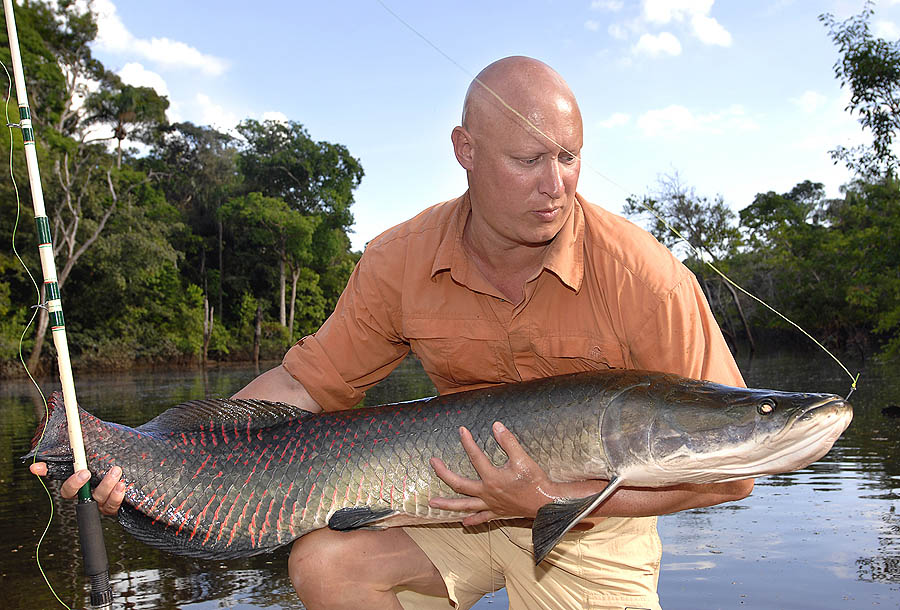
Well, I had just one day to try and catch my first arapaima. At the camp three Brazilian anglers joined me, and we caught 5 arapaima between 55 and 140 lbs that day. Besides arapaima, the lakes sport a solid variety of other interesting fish like Tambaquí/blackfinned pacu (Colossoma macropomum), Trahira/tiger characin (Hoplias malabaricus), peacock bass, various catfish species, and many more.
Tackle
For redtail catfish we used 50lb rods, multipliers with 0.80 nylon line or braided line, coated metal wire trace, and size 7/0-10/0 single hooks.
For shovelnose we used 30lb rods, multipliers with 0.50 nylon line or braided line, coated metal wire trace, and size 5/0-7/0 single hooks.
For peacock bass we used 20lb rods, spinning reels with 0.30 nylon line or braided line, and artificial baits or size 8/0 circle hooks for live bait.
We also used fly gear for peacock bass, aftm class #9, and streamer type flies.
 The big Tucunaré/Peacock Bass
The big Tucunaré/Peacock Bass
The peacock bass is really a cichlid, in the big order of perch-like fishes – but the bass association is plainly obvious when you see the fish, especially with its huge mouth – it really looks like an oversize, aquarium fish coloured largemouth bass. In the Amazon system there are several different species of peacock bass, where at least 5 of them grow big.
In 2006 scientists made new descriptions of the peacock bass species, and narrowed down distribution more thoroughly. The species we fished for in the Sucundurí system are Cichla pinima og Cichla monoculus.
Cichla pinima was previously confused with Cichla temensis, but in all honesty, they do look much the same. Both can reach lengths of up to 1 metre and more than 25 lbs in weight, and it is normal to catch them at 10 to 15 lbs. Cichla pinima is found in the southern tributaries of Amazonas, like Rio Xingú.
Rio Tocantins, Rio Tapajós, and the upper parts of Rio Madeira, including clear water tributaries (where we fished). Cichla temensis is found in Rio Orinoco, Rio Negro and the lower parts of Rio Madeira.
Cichla monoculus is widely distributed throughout the Amazon basin, and it is easily identified by the black markings behind its pectoral fins. This species grows to about 20 lbs / 70 cm, however, it is not common to catch them at more than 7 lbs.
Besides these peacock bass, there are a couple more species, which grow big, Cichla ocellaris and Cichla orinocensis. Cichla ocellaris is often confused with many of the smaller species, and they do look much alike. These species can only really be determined by either exact origin and/or precise scale count. Cichla ocellaris is found in Rio Branco, Rio Essequibo and Rio Courantine, and it grows to about 15 lbs / 70 cm.
Cichla orinocensis is found, as the name suggests, in the Rio Orinoco basin, and Rio Negro basin, and it grows to over 13 lbs / 60 cm.
